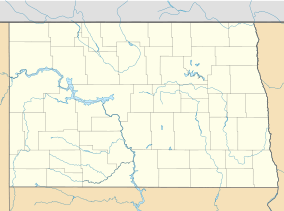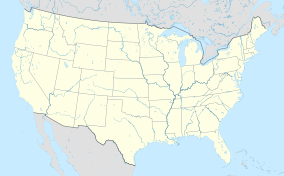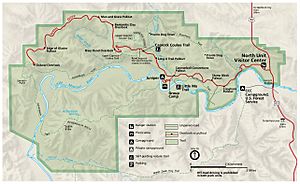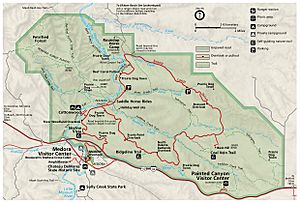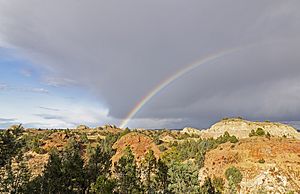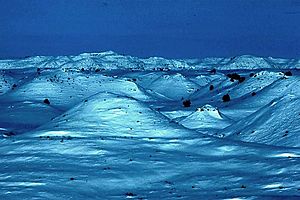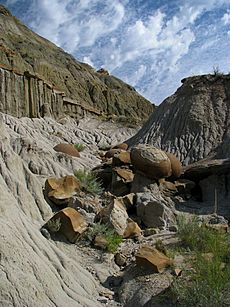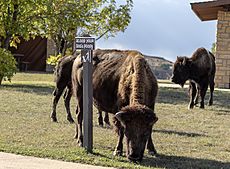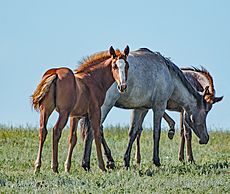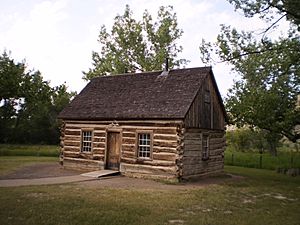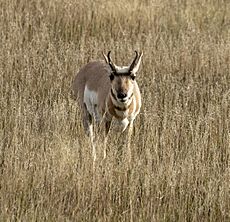Theodore Roosevelt National Park facts for kids
Quick facts for kids Theodore Roosevelt National Park |
|
|---|---|
|
IUCN Category II (National Park)
|
|
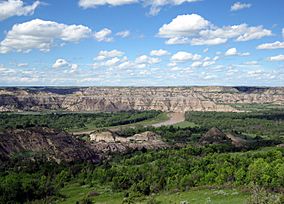
View of the badlands and the Little Missouri River
|
|
| Location | Billings and McKenzie counties, North Dakota, United States |
| Nearest city | Medora |
| Area | 70,446 acres (285.08 km2) |
| Established | November 10, 1978 |
| Visitors | 749,389 (in 2018) |
| Governing body | National Park Service |
| Website | Theodore Roosevelt National Park |
Theodore Roosevelt National Park is a special place in western North Dakota. It is a national park made up of three separate areas of unique land called badlands. This park is named after U.S. President Theodore Roosevelt. It is the only U.S. national park named directly after just one person.
The park covers about 70,446 acres (285 square kilometers). It has three parts: the North Unit, the South Unit, and the Elkhorn Ranch Unit. The bigger South Unit is next to Interstate 94 near Medora, North Dakota. The smaller North Unit is about 80 miles (130 km) north of the South Unit. Roosevelt's Elkhorn Ranch is located between the North and South units. The Little Missouri River flows through all three parts of the park. A long path called the Maah Daah Hey Trail connects all three units.
Both main parts of the park have beautiful drives. They also offer about 100 miles (160 km) of trails for walking and horse riding. You can see lots of wildlife here. It is also a great place for hiking and camping in the wild. In 2018, over 749,000 people visited the park.
Contents
Exploring the Park's Geography
The North Unit, South Unit, and Elkhorn Ranch Unit together cover 70,446 acres (285 square kilometers). The park's larger South Unit is located near Medora, North Dakota, right by Interstate 94. The smaller North Unit is about 80 miles (130 km) north of the South Unit. It is on U.S. Route 85, just south of Watford City, North Dakota. Roosevelt's Elkhorn Ranch is found between the North and South units. It is about 20 miles (32 km) west of US 85 and Fairfield, North Dakota.
A Look at the Park's History
Theodore Roosevelt's Connection to the Park
Theodore Roosevelt first came to the North Dakota badlands in September 1883. He came to hunt bison. On this short trip, he found his bison. He also fell in love with the tough life and "perfect freedom" of the West. He bought a share in the Maltese Cross Ranch. This ranch was seven miles south of Medora.
After his wife and mother both died on February 14, 1884, Roosevelt returned to his ranch. He wanted peace and time to heal. That summer, he started his second ranch, the Elkhorn Ranch. It was 35 miles north of Medora. Roosevelt was very interested in his ranches and hunting. He wrote about his experiences in newspapers and magazines. His time in the outdoors and losing his cattle in a harsh winter shaped his ideas. These experiences influenced his work to protect nature when he became President of the United States (1901–1909).
Fun Things to Do and See
Both main parts of the park have scenic drives. There are also about 100 miles (160 km) of trails. You can walk or ride horses on these trails. It is a great place to watch wildlife. You can also go hiking and camping in the backcountry. There are three main campgrounds. These are Juniper Campground in the North Unit and Cottonwood Campground in the South Unit. There is also the Roundup Group Horse Campground in the South Unit.
One of the most popular activities is watching the animals. Bison live here and can be dangerous. Visitors should always watch them from a safe distance.
The scenery in the park changes with the seasons. From late summer through winter, the grass is brown. But in early summer, it turns green. Hundreds of types of flowers also bloom. Winter can be very beautiful. Snow covers the sharp hills of the badlands. Theodore Roosevelt called it "an abode of iron desolation."
The badlands were very important in Roosevelt's life. The park remembers his efforts to protect America's nature. At the South Unit Visitor Center, there is a museum. It tells the story of Roosevelt and his ranching days. Roosevelt's Maltese Cross Cabin is also there. You can visit it all year round.
Roosevelt's Elkhorn Ranch is a separate, quiet part of the park. It is 35 miles (56 km) north of Medora. You can reach it by gravel roads. Ask park rangers about road conditions before you go. The foundations of the ranch house are still there. Other parts of the cabin were moved and used elsewhere after Roosevelt left. New oil development nearby could affect the Elkhorn Ranch. This includes noise and things that block the view.
The park is popular for hiking and horseback riding in the wild areas. You can get permits for camping in the backcountry at the visitor centers. With over 100 miles (160 km) of trails, it is a great hiking park. But remember, water and shade are limited on the trails. The park is mostly surrounded by Forest Service grasslands. The night skies here are very dark. This makes it excellent for stargazing. Sometimes, you can even see the northern lights.
The entire park is surrounded by a 7-foot (2.1 m) tall fence. This fence keeps bison and wild horses inside the park. It also keeps farm animals out. Other animals can get over, under, or through the fence at special spots.
The town of Medora is at the entrance to the South Unit. It offers a fun western experience. You can find wooden sidewalks, old-fashioned ice cream shops, and buggy rides. There are also several museums. The Burning Hills Amphitheater has nightly shows of the Medora Musical. These shows run from early June to early September.
Park officials manage the numbers of bison, horses, and elk. This helps keep the ecosystem balanced. Biologists also watch the prairie dog towns. The park only controls prairie dog numbers if they threaten buildings or human health.
Climate in the Park
The climate at Theodore Roosevelt National Park is mostly dry with cold winters. The North Unit Visitor Center has very cold winters. The average lowest temperature is about -30.6 °F (-34.8 °C). The South Unit Visitor Center is a little warmer. Its average lowest temperature is about -29.3 °F (-34.1 °C).
| Climate data for North Unit Visitor Center, Theodore Roosevelt National Park. Elev: 2198 ft (670 m) | |||||||||||||
|---|---|---|---|---|---|---|---|---|---|---|---|---|---|
| Month | Jan | Feb | Mar | Apr | May | Jun | Jul | Aug | Sep | Oct | Nov | Dec | Year |
| Mean daily maximum °F (°C) | 25.2 (−3.8) |
30.7 (−0.7) |
41.9 (5.5) |
57.9 (14.4) |
68.4 (20.2) |
77.1 (25.1) |
85.2 (29.6) |
85.0 (29.4) |
73.3 (22.9) |
58.1 (14.5) |
40.3 (4.6) |
27.9 (−2.3) |
56.0 (13.3) |
| Daily mean °F (°C) | 14.6 (−9.7) |
19.8 (−6.8) |
30.5 (−0.8) |
43.9 (6.6) |
54.6 (12.6) |
63.6 (17.6) |
70.4 (21.3) |
69.5 (20.8) |
58.3 (14.6) |
44.7 (7.1) |
29.7 (−1.3) |
17.5 (−8.1) |
43.2 (6.2) |
| Mean daily minimum °F (°C) | 4.0 (−15.6) |
8.8 (−12.9) |
19.0 (−7.2) |
29.9 (−1.2) |
40.8 (4.9) |
50.1 (10.1) |
55.6 (13.1) |
54.0 (12.2) |
43.2 (6.2) |
31.3 (−0.4) |
19.1 (−7.2) |
7.1 (−13.8) |
30.3 (−0.9) |
| Average precipitation inches (mm) | 0.39 (9.9) |
0.30 (7.6) |
0.63 (16) |
1.03 (26) |
2.17 (55) |
3.04 (77) |
2.37 (60) |
1.68 (43) |
1.40 (36) |
1.37 (35) |
0.48 (12) |
0.41 (10) |
15.27 (388) |
| Average relative humidity (%) | 74.6 | 73.2 | 65.7 | 52.4 | 53.0 | 57.9 | 54.9 | 50.7 | 51.9 | 57.5 | 68.2 | 75.9 | 61.3 |
| Average dew point °F (°C) | 1.6 (−16.9) |
5.4 (−14.8) |
15.0 (−9.4) |
25.7 (−3.5) |
38.4 (3.6) |
50.8 (10.4) |
56.6 (13.7) |
55.7 (13.2) |
47.5 (8.6) |
34.4 (1.3) |
21.7 (−5.7) |
7.7 (−13.5) |
30.2 (−1.0) |
| Source: PRISM Climate Group | |||||||||||||
| Climate data for South Unit Visitor Center, Theodore Roosevelt National Park. Elev: 2382 ft (726 m) | |||||||||||||
|---|---|---|---|---|---|---|---|---|---|---|---|---|---|
| Month | Jan | Feb | Mar | Apr | May | Jun | Jul | Aug | Sep | Oct | Nov | Dec | Year |
| Mean daily maximum °F (°C) | 28.0 (−2.2) |
32.7 (0.4) |
43.3 (6.3) |
57.5 (14.2) |
68.0 (20.0) |
77.4 (25.2) |
85.5 (29.7) |
85.7 (29.8) |
73.8 (23.2) |
58.8 (14.9) |
41.8 (5.4) |
30.1 (−1.1) |
57.0 (13.9) |
| Daily mean °F (°C) | 16.9 (−8.4) |
21.2 (−6.0) |
31.3 (−0.4) |
43.6 (6.4) |
54.4 (12.4) |
63.7 (17.6) |
70.5 (21.4) |
69.8 (21.0) |
58.4 (14.7) |
45.0 (7.2) |
30.7 (−0.7) |
18.9 (−7.3) |
43.8 (6.6) |
| Mean daily minimum °F (°C) | 5.8 (−14.6) |
9.7 (−12.4) |
19.3 (−7.1) |
29.8 (−1.2) |
40.7 (4.8) |
50.1 (10.1) |
55.6 (13.1) |
53.9 (12.2) |
43.0 (6.1) |
31.2 (−0.4) |
19.6 (−6.9) |
7.7 (−13.5) |
30.6 (−0.8) |
| Average precipitation inches (mm) | 0.31 (7.9) |
0.31 (7.9) |
0.67 (17) |
1.15 (29) |
2.15 (55) |
2.81 (71) |
2.27 (58) |
1.34 (34) |
1.32 (34) |
1.14 (29) |
0.50 (13) |
0.31 (7.9) |
14.28 (363) |
| Average relative humidity (%) | 71.6 | 70.8 | 64.2 | 53.0 | 53.8 | 57.9 | 54.1 | 50.1 | 51.3 | 56.8 | 66.0 | 72.8 | 60.2 |
| Average dew point °F (°C) | 9.3 (−12.6) |
13.2 (−10.4) |
20.6 (−6.3) |
27.6 (−2.4) |
38.0 (3.3) |
48.6 (9.2) |
53.1 (11.7) |
50.4 (10.2) |
40.5 (4.7) |
30.6 (−0.8) |
20.7 (−6.3) |
11.6 (−11.3) |
30.4 (−0.9) |
| Source: PRISM Climate Group | |||||||||||||
Park Animals and Plants (Ecology)
The park has two main types of natural plant life. One is a mix of Wheatgrass and Needlegrass in a North Mixed grass prairie. The other is a Northern Floodplain area with Floodplain Forests.
The park is home to many animals that live on the Great Plains. These include bison, coyotes, cougars, wild horses, badgers, elk, bighorn sheep, white-tailed deer, mule deer, and pronghorn. You can also find prairie dogs. At least 186 types of birds live here. These include golden eagles, sharp-tailed grouse, and wild turkeys. Bison, elk, and bighorn sheep have been brought back to live in the park.
See also
 In Spanish: Parque nacional Theodore Roosevelt para niños
In Spanish: Parque nacional Theodore Roosevelt para niños


